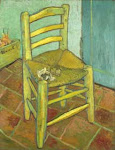Today is a special day for all lovers of ancient Greek art: the opening of the new Acropolis Museum in Athens. The New York Times has an article and slideshow, as do other news sites online. It is exciting to see the objects installed in their new home! Their old home was a cramped 1874 building wedged in a corner of the Acropolis, an environment that was not very safe for them given the massive number of visitors. I was always amazed something didn't get broken right in front of me during my visits, the way tourists sometimes paid no heed to what stood right behind them. No longer a problem -- from the pictures it is clear that there is ample room for the objects and for visitors to circulate and enjoy them.
Slide 2 on the NY Times slide show particularly made my heart go pitter-pat. At the top of the staircase in the photo are the remnants of a large painted limestone pediment, part of what scholars refer to as the "H-building" or "Hekatompedon." Dating from about 560-550 BC, that building predates the Parthenon that still stands today, and in fact, most scholars now are in agreement that it stood on the same site as the later structure. In the old Acropolis Museum, the H-building sculptures were tucked into rooms too small for them, too narrow for visitors to get a good look or a good picture. And yet, despite the lacunae in the sculptural composition, these are archaeologically very important objects. Finally! Now they are displayed to their best advantage. The bit you see there in the center shows a lion savaging a bull, an apotropaic power symbol appropriate for protecting a temple. In the other slides, you can see the beautiful new display of the Erechtheion caryatids (who also used to be cramped), some of the sculptures from the so-called Old Temple of Athena that predated the Erechtheion, assorted Archaic statues, and the famous Kritios Boy. The Archaic sculptures' smiles seem to indicate happiness with their new home! I wasn't sure how good the pieces would look in such a modernist building, but if the photos are any indication, the place is a knockout.
The top floor features some of the Parthenon sculptures, the ones that remain in Athens after various pieces were taken away in the nineteenth century. The Greeks are hoping that the museum's completion will re-energize debate about the ownership of those Parthenon sculptures missing from the new museum, namely those owned by the British Museum. Just last week, the British Museum offered a three-month loan of their sculptures in exchange for Greece formally acknowledging British ownership; not surprisingly, the Greeks refused. (In my opinion, the British knew they would say no. Because the three-month loan period seems ridiculous for some of the most important sculptures of the ancient world--to put it another way, I think it would be terrible to risk the safety and integrity of the sculptures by moving them for a three-month period. It was all politics, folks.)
The Acropolis Museum is conveniently located just south of the Acropolis. To get there, take the Metro to the -- guess what -- Acropolis stop. The museum is very near the station. I look forward to getting back to Athens and checking it out for myself...sometime!
Saturday, June 20, 2009
Subscribe to:
Post Comments (Atom)






2 comments:
That is a beautiful museum!
Your timing was perfect. I have just finished teaching a subject this semester called "Stolen Art" :)
Now for something totally different. I am asking art-related bloggers to name their favourite art gallery and say why. If you are interested in participating, please see "World's favourite art galleries".
thanks
Hels
Art and Architecture, mainly
Post a Comment